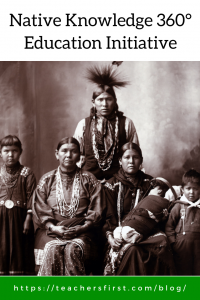On June 2, 1924, Congress enacted the Indian Citizenship Act, which granted citizenship to all Native Americans born in the U.S. Although this act provided Native Americans with many rights of citizenship, individual state laws determined voting rights. Until 1957, some states barred Native Americans from voting, and it wasn’t until the passage of the Civil Rights Act in 1965 that Congress removed all barriers to Native American voting rights.
This article, written by Christine Boatman in 2019, describes some of the issues educators face when teaching about Native Americans. One eye-opening fact mentioned is that as recently as 2011-2012, twenty-seven states didn’t include any individual Native Americans in their K-12 teaching standards. Ms. Boatman also shares excellent ideas for recognizing and filling in personal knowledge gaps and teaching resources that adequately address Native American history and emphasize current issues facing Native Americans.
Native Knowledge 360° Education Initiative (reviewed here) is an excellent starting point for finding transformative teaching materials, student programs, and professional development. Materials also include virtual access to the many primary source materials found in Smithsonian Museum collections. All resource materials, webinars, and training are free.
Some the highlights of this initiative are include in the Student Programs section: virtual field trips, upcoming student webinars, and recorded student webinars.
- Virtual Field Trips – Discover programs available for students in all grades. All programs require advance registration, and sessions fill up quickly. Sign up to receive the museum’s newsletter to receive notifications of new events. Students in grades K–3 learn about the historical significance of bison and the art of totem poles. Options for older students include math-based activities, indigenous innovations, and physics in action using Inuit snow goggles. Offerings are updated often and use Microsoft Teams or Zoom as a presentation platform.
- Lessons and Resources – A good starting point for this portion of the site is to browse through the featured items. These items include the newest additions to the lesson library, Helpful Handouts, posters, and teacher materials. Don’t be fooled by the term “Helpful Handouts”— these aren’t posters or worksheets. Helpful Handouts are informational resources that introduce educators to culturally sensitive activities and resources about topics related to Native Americans. After opening up the handout, click on the image to open the resource guide.
- Professional Development – Enroll in upcoming courses or view recent webinars provided by the Smithsonian Museum’s education department. Most webinars are about an hour long, making them an excellent choice for individual learning or watching with peers. Topics include environmental issues, using lessons from Native Knowledge 360° in your classroom, and changing the narratives on Native American Indians. One engaging webinar is a two-part session entitled “Giving Thanks: Telling More Complete Narratives in Your Classroom,” which relates to teaching about Native Americans during Thanksgiving.
Use these materials to provide a more comprehensive history of Native Americans told through a framework of essential understandings. These essential understandings integrate into a Culturally Responsive Teaching (CRT) Model to help students make meaningful connections to the material and allow them to develop and build their cultural identities.
Providing students with culturally accurate materials and inclusive discourse is always a good idea. Consider exploring and using the materials available from the Native Knowledge 360° Education Initiative to engage students in relevant and rich learning experiences that provide a realistic view of history and the Native American experience.
Have you used resources from the Native Knowledge 360° Education Initiative? Perhaps you have additional primary source lessons and activities to share. We enjoy hearing ideas and suggestions from our readers. Share yours in the comments below!



Very helpful and informative article. If you do not mind then I will share it.
Thank you